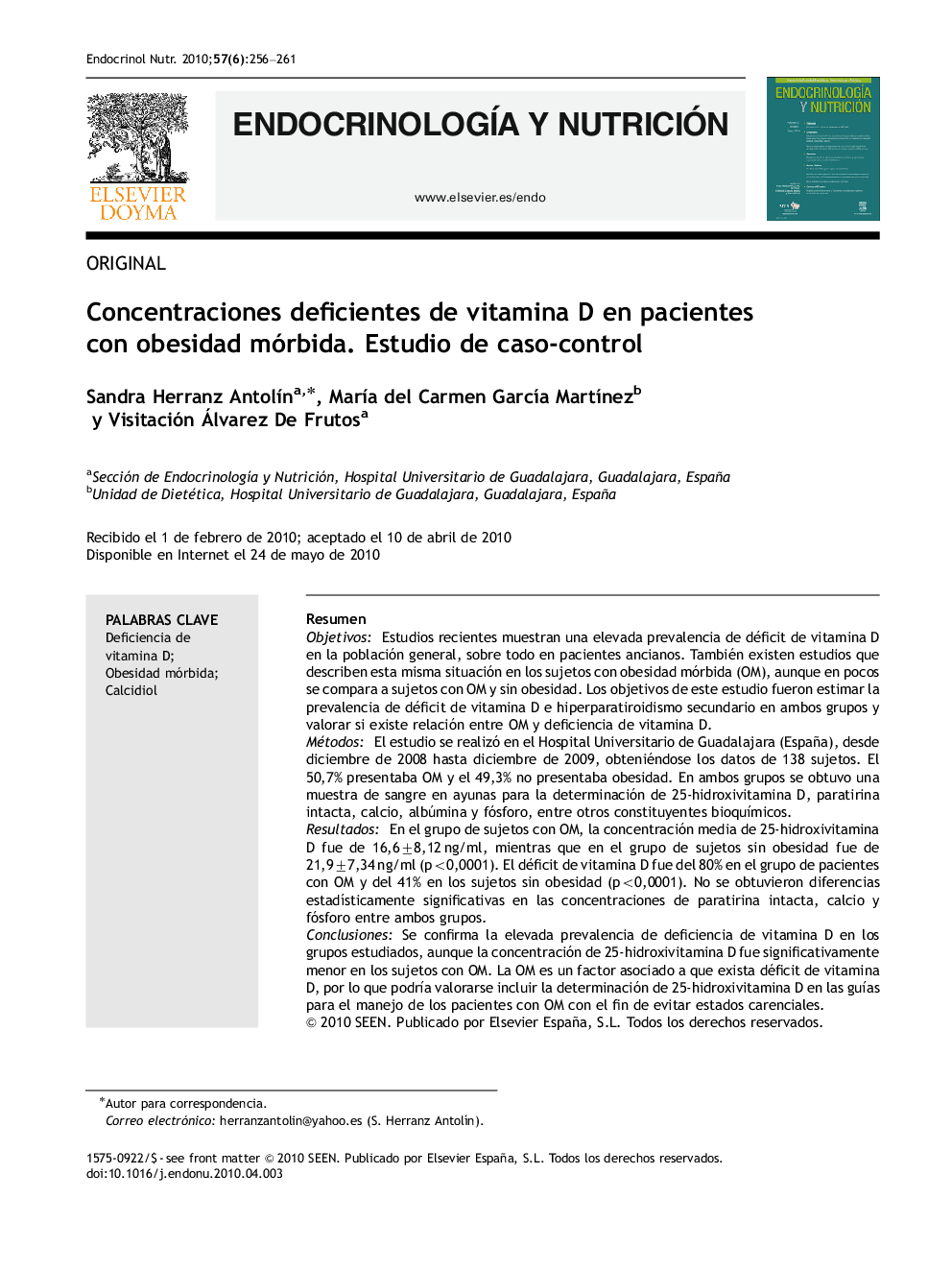| Article ID | Journal | Published Year | Pages | File Type |
|---|---|---|---|---|
| 2774048 | Endocrinología y Nutrición | 2010 | 6 Pages |
ResumenObjetivosEstudios recientes muestran una elevada prevalencia de déficit de vitamina D en la población general, sobre todo en pacientes ancianos. También existen estudios que describen esta misma situación en los sujetos con obesidad mórbida (OM), aunque en pocos se compara a sujetos con OM y sin obesidad. Los objetivos de este estudio fueron estimar la prevalencia de déficit de vitamina D e hiperparatiroidismo secundario en ambos grupos y valorar si existe relación entre OM y deficiencia de vitamina D.MétodosEl estudio se realizó en el Hospital Universitario de Guadalajara (España), desde diciembre de 2008 hasta diciembre de 2009, obteniéndose los datos de 138 sujetos. El 50,7% presentaba OM y el 49,3% no presentaba obesidad. En ambos grupos se obtuvo una muestra de sangre en ayunas para la determinación de 25-hidroxivitamina D, paratirina intacta, calcio, albúmina y fósforo, entre otros constituyentes bioquímicos.ResultadosEn el grupo de sujetos con OM, la concentración media de 25-hidroxivitamina D fue de 16,6±8,12 ng/ml, mientras que en el grupo de sujetos sin obesidad fue de 21,9±7,34 ng/ml (p<0,0001). El déficit de vitamina D fue del 80% en el grupo de pacientes con OM y del 41% en los sujetos sin obesidad (p<0,0001). No se obtuvieron diferencias estadísticamente significativas en las concentraciones de paratirina intacta, calcio y fósforo entre ambos grupos.ConclusionesSe confirma la elevada prevalencia de deficiencia de vitamina D en los grupos estudiados, aunque la concentración de 25-hidroxivitamina D fue significativamente menor en los sujetos con OM. La OM es un factor asociado a que exista déficit de vitamina D, por lo que podría valorarse incluir la determinación de 25-hidroxivitamina D en las guías para el manejo de los pacientes con OM con el fin de evitar estados carenciales.
ObjectivesRecent studies show a high prevalence of vitamin D deficiency in the general population, especially in the elderly. There are also studies reporting the same observations in the morbidly obese, although few of these studies have compared morbidly obese individuals with non-obese persons. The objectives of this study were to estimate the prevalence of vitamin D deficiency and secondary hyperparathyroidism in both groups and to assess whether there is a relationship between obesity and vitamin D deficiency.MethodsThis study was carried out in 138 patients in the Guadalajara University Hospital (Spain) between December 2008 and December 2009. Of these, 50.7% were morbidly obese and 49.3% were not obese. Fasting blood samples were taken from both groups for determination of 25-hydroxyvitamin D, intact parathyroid hormone, calcium, albumin and phosphorus, among other biochemical parameters.ResultsThe mean concentration of 25-hydroxyvitamin D was 16.6±8.12 ng/ml in the morbidly obese group and 21.9±7.34 ng/ml in the non-obese group (p<0.0001). The prevalence of vitamin D deficiency was 80% in morbidly obese patients and 41% in non-obese patients (p<0.0001). There were no statistically significant differences in concentrations of parathyroid hormone, calcium or phosphorus between the two groups.ConclusionsA high prevalence of vitamin D deficiency was found in both groups studied, although the concentration of 25-hydroxyvitamin D was significantly lower in the morbidly obese. Morbid obesity is closely linked to vitamin D deficiency. To prevent this deficiency, determination of 25-hydroxyvitamin D should be included in clinical practice guidelines for the treatment of obesity.
